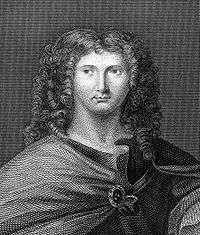Earl of Roscommon
- For Baron Dillon of the Holy Roman Empire, see Dillon baronets

Earl of Roscommon was a title in the Peerage of Ireland. It was created on 5 August 1622 for James Dillon, 1st Baron Dillon. He had already been created Baron Dillon on 24 January 1619, also in the Peerage of Ireland. The fourth Earl was a courtier, poet and critic. The fifth Earl was a professional soldier and courtier: he was friendly with Samuel Pepys, who refers to him several times as "Colonel Dillon" in his famous Diary. After the death of the tenth Earl, there were two prolonged investigations by the Irish House of Lords during the 1790s to ascertain the legitimacy of his son Patrick, against the rival claim by Robert Dillon, a descendant of the seventh son of the first Earl and the next male heir in line. These eventually found in Patrick's favour.[1] The titles became dormant on the death of the eleventh Earl in 1816. However, in 1828 the United Kingdom House of Lords decided that the rightful heir to the peerages was Michael Dillon, a descendant of the seventh son of the first Earl, who became the twelfth Earl. The House of Lords Lords decided against Francis Stephen Dillon (d 1840[2]), an inmate of a debtors' prison who dubiously claimed descent from the third son of the first Earl.[3] The titles became extinct on the death of the twelfth Earl on 15 May 1850.
The Viscounts Dillon and Barons Clonbrock were members of other branches of the Dillon family.They were a long-established Anglo-Norman family who were recorded in Ireland from about 1185, and held substantial lands in Meath, Westmeath, Longford and Roscommon. Sir James Dillon (died 1507), great-grandfather of the first Earl, was a distinguished judge, as were several of his descendants.
Earls of Roscommon (1622)
- James Dillon, 1st Earl of Roscommon (died 1642)
- Robert Dillon, 2nd Earl of Roscommon (died 1642)
- James Dillon, 3rd Earl of Roscommon (c. 1605–1649)
- Wentworth Dillon, 4th Earl of Roscommon (c. 1630–1685)
- Carey Dillon, 5th Earl of Roscommon (1627–1689)
- Robert Dillon, 6th Earl of Roscommon (died 1715)
- Robert Dillon, 7th Earl of Roscommon (died 1721)
- James Dillon, 8th Earl of Roscommon (1702–1746)
- Robert Dillon, 9th Earl of Roscommon (died 1770)
- John Dillon, 10th Earl of Roscommon (died 1782)
- Patrick Dillon, 11th Earl of Roscommon (1769–1816)
- Michael James Robert Dillon, 12th Earl of Roscommon (1798–1850)
See also
References
- ↑ MacDermotRoe, Ken. "ROSCOMMON PEERAGE TRIAL". MacDermot Roe, Biatach. Retrieved 26 March 2014.
- ↑ Longford Journal 30 May 1840
- ↑ Taylor, John Sydney (1829). The Roscommon claim of peerage. London: Saunders and Benning.